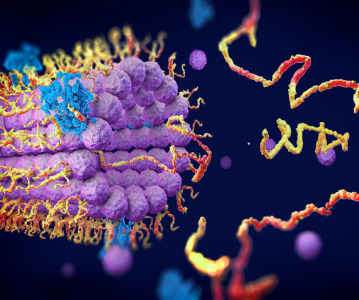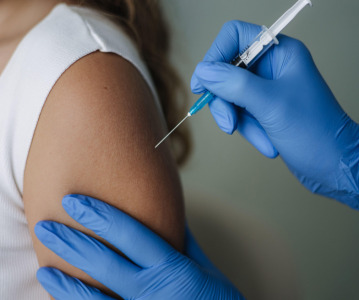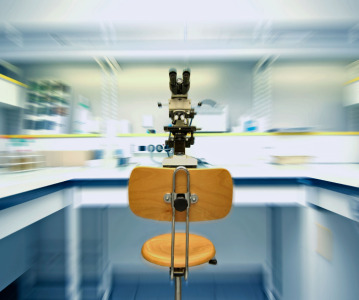Thinking Outside the Box, What's Driving R&D in Pharma Packaging?

Evolving patient needs, growing demand for traceability and increasing cost pressures have awakened innovation in the pharmaceutical packaging sector.
Packaging development is no longer just about creating containers that ensure drugs are stable on the pharmacy shelf. Nowadays designers must consider ease-of-access, traceability and compliance with regulations like the US Drug Supply Chain Security Act (DSCSA) [1] and the Falsified Medicines Directive in the European Union [2].
Ger Standhardt from the NVC Netherlands Packaging Centre told us “We mainly see things happening in areas that are pushed by legal requirements such as serialization, anti-tampering devices and patient-centric packaging design, including adherence packaging.”
Continued growth of the large molecule drugs sector and the emergence of cell and gene therapies are also impacting pharmaceutical packaging designed Standhardt says. “The main difference with biopharma products is that they are usually in liquid form and often require more environmental conditioning” he explained.
Patient-centricity
Patient centricity is impacting all types of packaging and delivery devices says Pierre Pienaar, president of the World Packaging Organization (WPO). He told us “Patients are and will always be at the centre of the pharma sector.
“If one looks over the years at the development of the industry, one will clearly see how well the pharma industry achieves this. They strive to make it easier for patients to comply with prescribed regimens.”
Pienaar cited the Epipen, Mylan’s epinephrine auto-injector for anaphylactic shock, as an example. He explained that by focusing on the patient, Epipen’s designers had given it an “ease of use in anxious moments.”
Other packaging design elements also reflect the focus on the patient says Pienaar, citing “printing on certain blister packs that remind the patient when to take their respective drugs” as an example.
Standhardt has also observed the trend. He told us “Patient centricity is certainly a buzzword and it creates opportunities for better packaging – or packaging that is better for the patient, not just for the supply chain and packaging operations.”
Global logistics
Another factor is the lengthening of supply chains. A drug taken by a US patient may have been manufactured locally or in a different continent. The challenge of protecting a medicine for shipment around the world is changing the packaging industry, particularly in its use of tracking technology says Pienaar.
“The integration of IT with all the other sectors and departments will ultimately prove critical, particularly with the logistics of getting the medicine to those patients in time, every time and in the right condition.”
Packaging innovation
Reinventing the wheel is usually not a good idea. The drug industry has been packaging medicines for more than one hundred years and effective designs and processing, filling and closing technologies are established. This has made some firms innovation averse according to Pienaar, who told us “The small molecule prescription drug sector is rather conservative in its approach to packaging development.”
However, other parts of the industry – such as the over-the-counter (OTC) and consumer healthcare sectors - are more open to innovation.
Pienaar told us “In recent years some multinationals have moved out of their comfort zone and ventured into unchartered territory in their ideas and thinking to embrace non-traditional packaging ideas. “This is great to see, especially in the OTC pharma sector,” he said, citing innovations like the recent introduction of tube packaging as an example.
Materials science and economics
Cost also impacts what drug firms expect of packaging suppliers. Companies want to protect drugs as effectively as possible. However, they also want to minimize spending and this is driving innovation in materials.
“The most important aspect of pharma packaging is shelf-life,” Pienaar told us, explaining that material science developers aim to find the ‘sweet spot’ where economics and performance are balanced. He added that “The pharma industry knows too well that an easy solution in material selection is to pick glass and aluminium. This is good for barrier, but it is not economical and sometimes impractical.”
“Fortunately there is plenty of work currently being done around the world in packaging science. R&D labs continuously come up with new barrier technology as they seek the right construction for a specific product which has good barrier and is economically sound.”
Patent loss
The pharmaceutical patent cliff and the corresponding growth of the generic drug sector are also impacting packaging development. In generics, price is the key battleground. The main reason non-branded drugs are cheaper than branded equivalents because they do not need to be examined in clinical trials.
However, other factors like manufacturing and packaging cost also play an important part in keeping prices low according to Pienaar. “The challenge is to make generic drug prices competitive and this is where costings are focussed on. The development of packaging materials continues to aid the reduction of costs.”
He added that “Technologists and engineers help industry find the most suitable type of packaging that best fits the pricing structure without compromising product quality, thus ensuring a good reliable medicine is available at a fair price.”
Procurement challenges
Packaging procurement is another area where pharmaceutical companies seek to minimize costs. The packaging sector, like the drug industry, is global. A medicine made in India could be sealed in a blister-pack made in Europe and put in a box made in China before being shipped to the US.
Effective packaging procurement in a highly globalized market can be a challenge according to Pienaar, who says “The relationship between sales, procurement and packaging development is paramount.”
He explained that when such interaction does not take place there can be problems. “Sometimes procurement departments are fed outdated or incorrect data which impedes their ability to order.”
“In such circumstances, knowledge of the global packaging market is important because alternative sources may need to be identified quickly to prevent supply interruptions”, Pienaar said.
Future packaging
Biopharmaceutical packaging is an active area of R&D. In particular, there is a need for improved primary and secondary packaging technologies for large molecule drugs or cell and gene therapies.
While current packaging solutions are adequate, efforts to create technologies that are better able to protect these highly sensitive medicines continue, according to Pienaar, who told us he is confident the industry can rise to the challenge.
“Having been in packaging for over 35 years, having a pharmacy background and having crossed the globe many times in my role as WPO President, I can comfortably say that the packaging industry will once again rise to the challenge as it has done so well for the past 35 years. I know they will again seek the correct solution to develop packaging for cell and gene therapies.”
Standhardt is also positive about the level of innovation going on in the packaging sector, particularly the input being provided by large pharmaceutical and healthcare companies. He said, “I really like the way UCB approaches its packaging designs with a lot of patient involvement, but the way Abbott has launched its metered liquid dosing device in India is also very nice.”
The latter device – called LiDoCon – premiered in India in 2017 [3]. It is designed to deliver measured doses of liquid pharmaceuticals and over-the-counter medicines in a hygienic and convenient manner.
At the time, Raviraj Pillai, head of Abbott's pharmaceutical Innovation and Development Center in Mumbai said the device “provides safer, more accurate and convenient dosing of liquid medicines, ultimately making it easier for people to take their medicine and get better."
Digital packaging
The use of so-called ‘digital packaging’ is also going to increase in the future according to Chris Waterhouse, managing director of consulting group iDiPac, who cited personalized medicine as a potential area of application.
He told us “Structurally, digital ‘print’ systems can meet future needs. For example, digital capabilities facilitate the move to smaller batch sizes, including in areas like cell and gene therapy where a product is manufactured for a specific patient.
“The digital approach is flexible and agile, which means it is well suited to the personalized medicine where the ability seamlessly interact with the patient, manufacturing and supply chain is vital,” he said.
Smart bar codes on pharmaceutical packaging are also likely to become more common Waterhouse says, explaining that their ability to provide the patient with information and return data to healthcare professionals has multiple potential benefits.
“For the patient, better outcomes are achieved. For Governments, smart barcodes can lower costs. And for the drug industry they can increase sales,” he said, explaining the ability to track the percentage of prescribed drugs that are taken can help shape production and marketing efforts.
The complete package
As drug industry requirements continue to evolve, packaging developers will need to continue innovating. The sector’s ability to combine patient and regulatory demands with innovative design will be key to creating the next generation of drug packaging for the 21st century.
If you're looking to meet the leading manufacturers and developers of pharma packaging solutions, learn the latest developments through quality conferences and access unparalleled networking opportunities we offer a portfolio of CPHI and Pharmapack exhibitions in all major pharma markets throughout the year - take a look at our event calendar for more information.
References
[1] https://www.govinfo.gov/content/pkg/PLAW-113publ54/pdf/PLAW-113publ54.pdf
[2] https://ec.europa.eu/health/sites/health/files/files/eudralex/vol-1/dir_2011_62/dir_2011_62_en.pdf
Related News
-
News CPHI Podcast Series: The power of proteins in antibody drug development
In the latest episode of the CPHI Podcast Series, Lucy Chard is joined by Thomas Cornell from Abzena to discuss protein engineering for drug design and development. -
News Amgen sues Samsung biologics unit over biosimilar for bone disease
Samsung Bioepis, the biologics unit of Samsung, has been issued a lawsuit brought forth by Amgen over proposed biosimilars of Amgen’s bone drugs Prolia and Xgeva. -
News CPHI Podcast Series: Why we need to consider women in clinical trials
The latest episode of the CPHI Podcast Series with Lucy Chard covers women's health, specifically women's representation in clinical trials, the associated bias, and the impacts on health for this population. -
News US FDA does not approve MDMA therapy for PTSD, requests more data
The MDMA-based therapeutic developed by Lykos Therapeutics, a California-based Public Benefit Corporation (PBC), has been reviewed and unapproved by the US FDA. The regulator has requested additional phase III trial data for further safety and efficacy... -
News Novartis and Viatris latest facing lawsuit over HeLa cell misuse
Global pharmaceutical companies Novartis and Viatris are the latest hit with a lawsuit claim pertaining to alleged misuse of the ‘HeLa’ cell line from the estate of woman whose cancerous tissue cells were taken without consent. -
News Sanofi invests billions into Frankfurt insulin production site
French pharmaceutical company Sanofi have announced an investment of EUR1.3 billion at their existing BioCampus site in Frankfurt am Main for the expansion of insulin production. -
News Novel oral Type 1 diabetes drug gains US FDA IND designation
A University of Alabama at Birmingham startup has gained FDA clearance for Investigational New Drug clinical trials for an oral Type 1 diabetes drug, a milestone for diabetes treatment. -
News A Day in the Life of a Vice President in R&D & Engineering
In the Day in the Life of Series, we've already had the chance to get to know a range of people in various roles in the pharma industry. In the latest interview we get a glimpse into the R&D side of things from Jennifer Sorrells, Vice Presiden...
Position your company at the heart of the global Pharma industry with a CPHI Online membership
-
Your products and solutions visible to thousands of visitors within the largest Pharma marketplace
-
Generate high-quality, engaged leads for your business, all year round
-
Promote your business as the industry’s thought-leader by hosting your reports, brochures and videos within your profile
-
Your company’s profile boosted at all participating CPHI events
-
An easy-to-use platform with a detailed dashboard showing your leads and performance

.png)

.png)
.png)
.png)
.png)
